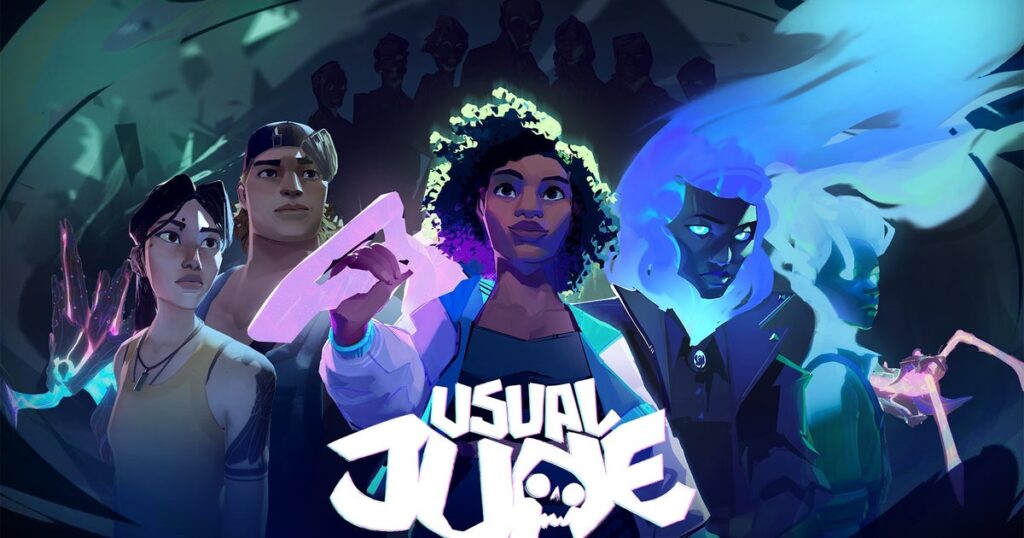Feeling seen: Handling marginalised representation in Usual June

Back in 2020, Finji CEO Rebekah Saltsman and creative director Adam Saltsman were figuring out how to follow-up Overland. Set in a post-apocalyptic world, that game is a far cry from what the duo set their sights on next – the ghostly supernatural vibes of Usual June.
“We knew that whatever we did next, we wanted to do it together,” Rebekah Saltsman tells GamesIndustry.biz. “We wanted a main character, we wanted to do something more action based, and we wanted to tell a story that we both really cared about.”
That story follows the titular character June, who is far from usual. For one, she can talk to ghosts, and she uses this ability to aid her investigation into the town of Fen Harbor and fight supernatural creatures across multiple dimensions.
However, at its heart Usual June is about championing marginalised people and their stories. For Saltsman, it was important for marginalised players to form a connection with the game and see themselves reflected in its characters.

“It’s lovely when you see a trailer for a game, especially if you’re someone who is less represented in games, and think: ‘Somebody sees me.’ There’s someone who sees me as a person who came to action games late. But someone also sees somebody like my husband who is obsessed with Dark Souls and Elden Ring.
“With Usual June, there’s a low floor for people like me who aren’t particularly good at action games, but are totally there for it so you can style your way through the game.”
Saltsman explains that this is why it was important to provide the necessary tools to players with different skill sets, including special abilities.
Dashing makes you invulnerable for a period of time, while another slows time in battle but also when you open menus “to ensure you’re able to have the option to access the things that you need to do.”
“Players have a lot of tools at their disposal,” she says. “You get to go through these sequences with the tools that you’re comfortable and familiar with. If you want to learn how to use them, we give you the opportunity to gradually add them.
“It’s really important to me that the game is inviting. Really high level players are getting good experience, but then people who want to play so badly aren’t going to be tossed out of it because they’re not good enough. There is a pathway through that is fun and we’re going to teach you bit by bit as you go, so you can feel confident using the extra tools.”
Saltsman adds: “More advanced players may think, ‘Oh, this is really easy.’ Not that Usual June is easy, but it feels really natural. For newer players, we give you the space to learn, which is us wanting more people to play games.”
Another way to attract players to Usual June was by utilising familiar genres.
“Both Adam and I love genre films, so we wanted to walk that edge between true horror and really good stories. And in a lot of cases, normal, ordinary people put in extraordinary circumstances with their friends. We love media like that, and it’s not really represented well in games. And when you start adding more diverse voices into games, you end up with more diverse stories.
“The game isn’t operating in a space that people are unfamiliar with. And then I think to myself, ‘Well, why is no one doing games in this space? That’s weird, because these stories are great’.”
During development, the team looked to media they were fans of that fit these genres. Usual June draws inspiration from TV shows like Buffy the Vampire Slayer and Veronica Mars, as well as games such as Bayonetta and Control. Saltsman also mentions the Spider-Verse films as a major influence for the game’s overall art style.
But it was the Netflix series I’m Not Okay With This that provided the most inspiration. The show follows a teen navigating her day-to-day life as she deals with having superpowers.
“We watched that show and were like, ‘This feels like if Mae from Night in the Woods had powers’,” Saltsman exclaims. “We were already making [Usual June] at this point, but thought: ‘Oh, that’s a really cool touch point’.”
“When you start adding more diverse voices into games, you end up with more diverse stories”
As for setting, Usual June takes place in a town based on the Midwest American towns that Saltsman and the team were familiar with.
“They’re weird places full of cool people with weird old stories and their own urban legends,” she smiles. “The United States is a big place, and we often only hear stories about coastal locations rather than those interior places where so many of us actually grew up.”
Saltsman notes that modelling the buildings on those found in these places added to the team’s storytelling capabilities.
“These locations are intentionally built to look like these old American towns that were established in the 1800s, but the buildings have turned into twenty other things since,” she explains.
“You might visit my city of Grand Rapids, for example, and walk into a coffee shop and you can tell it used to be a factory, then it might have been a dentist office at some point. All of that [history] is just there.
“So when you start ripping out walls, you’re left wondering… ‘Are those teeth in there? When was this a dentist office, and for how long? Does it have ghosts, too?’ That was part of the early foundational levels of the art direction in Usual June, especially the human places.”
These spooky locations speak for themselves, and are intertwined with the overall story which is told through large narrative sections.
“We have big narrative and investigative sections in the Earth realm, while in the other space June can access there are narrative fragments as you play through the action sequences,” Saltsman explains, adding that June will run into ghosts in this realm that become companions during these moments.
“They’re not necessarily fighting alongside you. Instead, they help you with the story and provide the context of what’s going on there. In general, the ghosts are able to aid and assist you by either giving you information or a piece of themselves to help you in combat.”
“It’s really important to me that the game is inviting”
For a game with a lot of narrative, there’s no spoken dialogue. The characters produce sounds, but the dialogue is text-based. So why take this route?
“There’s a lot of reasons for this,” Saltsman explains. “One is personal preference, the other is that [recording] voice – especially for an indie team of our size – is so astronomically out of budget. You have to have the script done so early, then you’re moving into acting… The timing is crazy, the budgets are bananas. And even with a well funded team, it’s still very expensive.”
Saltsman says that using Vocaloid, a voice synthesiser program, rather than spoken dialogue not only added atmosphere to the game, it also helped distinguish between the different characters.
“It’s been a really big part of figuring out how to make these characters sound individual, and also how to follow the sentence structure,” she explains.
“If you’re asking a question, does it sound like a question? If the character is excited, if they’re whispering, if they’re yelling, how do you make that sound? It was a really tricky problem but Adam Hay is brilliant. He spent an incredible amount of time honing the sound – it sounds like nothing else.”
Source link : Gamesindustry


